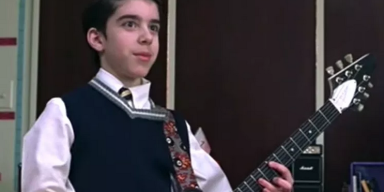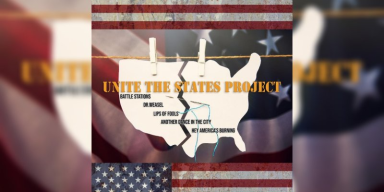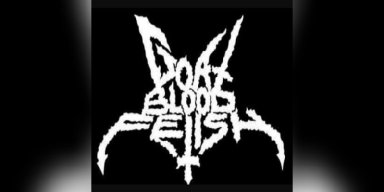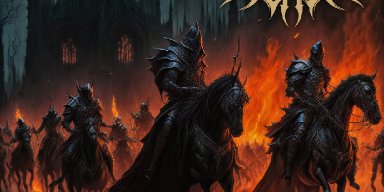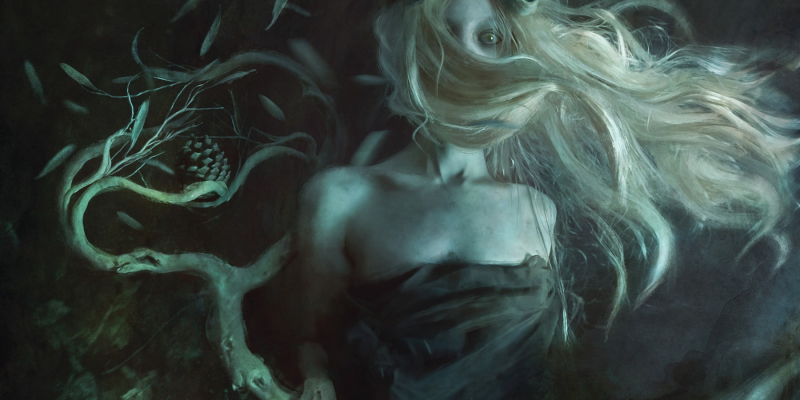
AUTUMN TEARS - The Glow Of Desperation Reviewed By Jenny Tate ! Check it out here at this link: https://jennytate.wordpress.com/2021/06/11/autumn-tears-the-glow-of-desperation/
Neo-classical band Autumn Tears present their new album, ‘The Glow Of Desperation’. Following on from their esteemed 2020 double album, ‘The Air Below The Water’, ‘TGOD’ is over an hour long, available as limited edition CD and online. The concept behind ‘TGOD’ is the physical manifestation of desperation, in luminescent form and the hope that comes as the flipside of that.
Featuring a whole host of orchestral, classical contributors, the album also sees the return of vocalist/lyricist Brona McVittie.
With analogue mastering by Sound Mixology’s Michael Vena, ‘TGOD’ comes with a 20 page booklet, featuring all lyrics and stunning artwork, by the award-winning Marcela Bolívar.
The Shadow Of Perseverance – Very mysterious intro, tinged with Eastern mysticism. A gradual build-up of ambient sounds, blending many vocal features. It’s quite eerily atmospheric. Gentle piano tones tinkle, alongside breezy vocals, via deep low depths and an air of unexplained quiescent, yet unsettling warning. There, it ends.
Cast Your Eyes To Behold Me – Solid strings intro, on a classical poignancy. Beautifully melancholic vocals follow. Joined by supportive male vocals and dramatic drum beats, it’s immediately clear that this is far more classical than metal. A choir of voices move it up, through the higher registers, with a notably operatic mood. Quite Aythis-esque, in its darkness. Drum and vocal build-up, bringing it to an end.
For Only A Day – Gentle, mellow strings open, onto another classical audio-scape. It’s very much mood based, with a strong theatrical flavour. The vocals reach up to high-end pitches and they’re undeniably beautiful and tasteful, even if there’s no real evidence of a metallic element, yet. It’s got melody, in spades and the delivery’s flawless. Building the power, through shared masculine and feminine vocals, before the end.
Reunion – Opening on a melancholic, but hopeful piano section and slightly more powerful vocals. It lifts, as the strings enter. Still, it’s not showing a clear metallic aspect at all. The performance is astonishing, in terms of skill base and conveyance of mood and atmosphere. It’s just pure classical, rather than a balance of classical and metal.
For You The Nameless……We Sing – Another fragile piano intro, loaded with melancholia. Male vocals enter first, this time. Similarly effective, in atmospheric terms, but more operatic than anything else. It paints the visual picture well, deftly accompanied by delicate piano tones. It’s just that again, it’s singularly classical. I’ve yet to hear any metal at all. Raising the vocal tone and tension, at the end.
Knowing All Has Been Decided – Rapid rain rhythm piano notes open, once more. Very skilful, in their application. Well matched by the soft feminine vocals. Fluidly delivered, with a lot of motion. An angelic duet soars skywards, before coming to land, at the close. Where’s the metal, though?
How Still The Day – Deep down singular piano tones intro, onto a matching vocal landscape. Very wintry, lyrically and melodically, resembling a haunting Christmas Carol. It’s unarguably beautiful. It just isn’t metal. Some very shrill, piercing notes hit with sheer precision. This is a very classy performance indeed. You’d have to be a philistine not to see that, but still, the fact remains. Neo-classical metal should be just that – an equal balance of both. This is, again, very much neo-classical, without the metal.
We Can Almost Hear Them – Very dark intro! Loaded with nostalgic melancholia. Gorgeously vocalised duet. Just as before, though, coming across as anything but metal. In fact, this could easily be the soundtrack to a brooding period drama or classic period film. Something surprisingly Judy Collins-esque about this track. It’s definitely got a lot of that kind of mood within it. It’s just so mood-lowering.
Succumb – Very similar intro style, again. Here, the mood sings, through the strings. It’s another wintry sounding track, with a focused vocal emphasis. The tones are still quite bleak, but do lift, here and there. As with the rest, there’s no faulting those incredible lilting vocals. The Celtic edge reveals itself here, at least. It’s just that metal eludes it, completely.
Throw It Over – Sadness and solemnity prevail in this opening, both instrumentally and vocally. Ooh, okay, what’s happening now? It appears some influence has been borrowed from ‘The Gollywog’s Cakewalk’, here! A bit of a bizarre rhythmic deviation, but at least it lifts the mood, a tad. You might say it actually highlights the ghostly vocal evocations, further, though. The call and response interplay does add something extra to it, however. We’re still in opera territory, even so. Finally ending, on a shrill duetted tone.
The Voice Of Spring – Thankfully, a marginally lighter intro. There’s a glimpse of springtime flowers and sunshine, but it seems the melody’s determined to retain the shadow of darkness and wintertime. A classic operatic vocal solo contradicts itself, lyrically, with the claim that ‘this is the voice of spring’. Sorry, but it just doesn’t sound like it. If anything, it’s beginning to sound like eternal winter. Yes, it’s unequivocally accomplished, artistically and precisely delivered, but it’s inherently depressing.
Wordless Waltz – A fitting intro sound, for the title, yet still, it conveys some sort of deep-seated, inescapable trauma. However beautifully performed it is and it is, it’s just carrying a claustrophobic streak of pain. If it was going for ghostly, haunting sadness and grief, then it’s succeeded.
Stasis – Very much the same. The piano intro and closely following strings appear to be lost in insurmountable grief. Once again, that eerie Judy Collins-esque sense enters the vocals. A slightly stronger structure to that duet and the surrounding accompaniments. Now, an oddly placed brass section appears. That just adds even further, to the depressing gloom. It’s lyrically descriptive and in that sense, it works, but yet again, this just holds no semblance of metal, whatsoever.
Human Artefact – Tinkling raindrops open, via piano, with an even more deeply ingrained morbidity. This time, the masculine duet paints a picture of some heinous event, or other, in between flashing rare glimpses of light. It seems they’re determined to overshadow it, with darkness, though, underlined by the chorus. Whilst the feminine vocals convey higher pitches, the overall mood just kills any prospect of hope.
The Glow Of Desperation – No reprieve, it seems, as yet another doom-laden piano intro brings with it even more gloom, well matched, by the lyrics. It’s well harmonised and here, the drums do bring a much-needed edge. Still, the whole melodic and lyrical narrative drags your mood down, to the doldrums. No qualms with the artistic performance. Quite the opposite. It still remains an exercise in depression, though.
Overall – As melodically and vocally precise as this is, my main beef with ‘The Glow Of Desperation’ is that as a neo-classical metal album, it should, obviously contain some metal. It doesn’t. It’s pure classical operatic, without any metal, at all. Credit must be given to the band, for their impressive level of artistry and peak precision delivery. That’s not in question. However, not only is ‘TGOD’ firmly in the classical operatic genre and nowhere near metal, it’s also stultifyingly morose and mood destroying, to the point of being desperate for it to end, so in that sense, it lives up to its name. Only it’s a deep, dark hole, rather than a glow of desperation.
8/10 ******** - Jenny Tate
Neo-Classical Band AUTUMN TEARS Reveals The Glow Of Desperation
FOR IMMEDIATE RELEASE:
April 21, 2021 - After the highly acclaimed 2020 double album The Air Below The Water, AUTUMN TEARS is thrilled to present their newest offering The Glow of Desperation, featuring 64 minutes of brand new music, presented as a limited CD and digital download.
FFO: Madder Mortem and Third and the Mortal
"To put it simply enough, the theme of the album to be construed is that sometimes we get so desperate that it actually manifests into luminescence. All of the songs actually deal With some form of hope and desperation."
The Glow of Desperation features a fully orchestrated, classical ensemble as well as:
Classical / opera singer & composer Caroline Clarke (Trovatori),
Singer / songwriter Tamar Singer (Zeresh, Cruel Wonders, Necromishka),
Singer / composer / vocal coach Anne "Anaé" Laurent (Anaé & The Petrichor, Adrana),
Tenor opera vocalist Darren Clarke (Trovatori),
Lead vocalist Agnete Mangnes Kirkevaag from the legendary
Norwegian progressive metal act Madder Mortem
Mark Garrett from the avant garde, progressive metal act Kardashev
Classical / opera singer Ann-Mari Edvardsen Alexis, best know as the Former vocalist of Norwegian doom metal / avant-garde band The 3rd and the Mortal (Nightswan, Painting on Glass, In This Room).
Also returning is singer / songwriter Brona McVittie.
Analog mastering by Michael Venia from Sound Mixology.

The CD features a 20 page lyric booklet lavishly illustrated with paintings by award winning artist Marcela Bolívar - http://www.marcelabolivar.com
Follow the band at these links:
https://www.facebook.com/TheTrueAutumnTears
https://open.spotify.com/artist/32WFfO8pMkrpupMgDiXlDE?si=VR6ePdo8R-uPKGNniK6P2g
https://www.youtube.com/channel/UCkKsJaicCl1nPIKZOdawhpA

Reviews - Interviews - Promo - Radio Play
Contact zach@metaldevastationradio.com





